Aerospace In Mexico Market Size
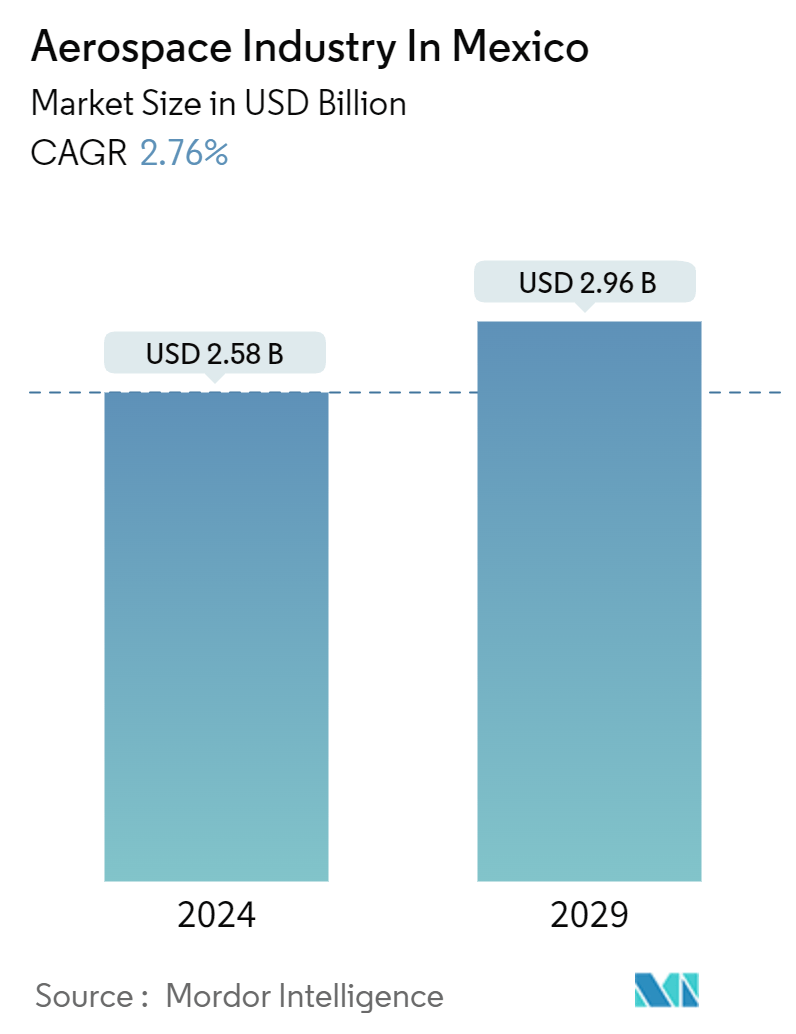
| Study Period | 2019 - 2029 |
| Base Year For Estimation | 2023 |
| Market Size (2024) | USD 2.58 Billion |
| Market Size (2029) | USD 2.96 Billion |
| CAGR (2024 - 2029) | 2.76 % |
| Market Concentration | Low |
Major Players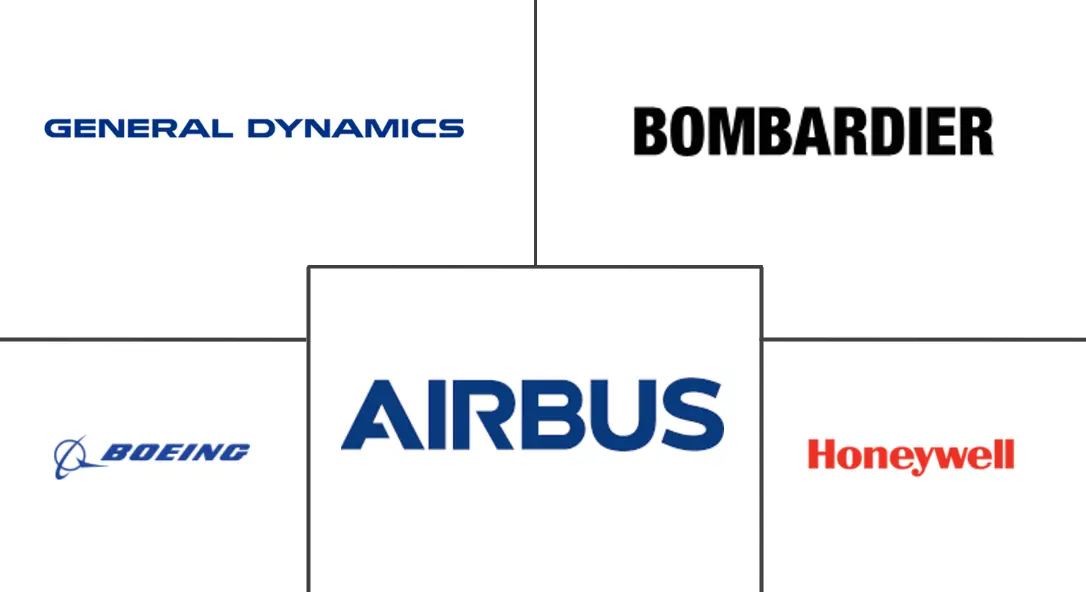
*Disclaimer: Major Players sorted in no particular order |
Aerospace In Mexico Market Analysis
The Aerospace Industry In Mexico Market size is estimated at USD 2.58 billion in 2024, and is expected to reach USD 2.96 billion by 2029, growing at a CAGR of 2.76% during the forecast period (2024-2029).
Mexico's strategic positioning, flanked by the United States and with access to the Pacific and Atlantic Oceans, establishes its role as a pivotal player in the global aerospace supply chain. The USMCA agreement bolsters trade fluidity, facilitating smoother cross-border operations and investments. Coupled with its geographical and regulatory advantages, this positions Mexico as an attractive hub for foreign direct investment, fostering regional economic integration within the aerospace industry.
Mexico's aerospace industry is buoyed by the worldwide surge in air traffic and the subsequent demand for new, more fuel-efficient aircraft. Airlines, in response, are ramping up efforts to modernize their fleets to meet stringent environmental standards. Consequently, there's a soaring demand for aerospace components and systems that Mexico, with its robust manufacturing capabilities and cost efficiencies, is well-equipped to meet.
However, Mexico's aerospace industry heavily relies on foreign technologies and expertise, presenting a double-edged sword. While this dependence can hinder local innovation, it also exposes the nation, given its size, to heightened risks from geopolitical tensions and trade restrictions, potentially impeding its technological advancements and collaborative ventures.
Aerospace In Mexico Market Trends
The Manufacturing Segment Will Showcase Remarkable Growth During the Forecast Period
Growth in the demand for air travel within the country will lead to significant growth in manufacturing new and technologically advanced aircraft to meet aviation requirements, driving market growth.
The Mexican government actively supports the strategic aerospace manufacturing sector through various measures, including incentives, tax breaks, and subsidies. Initiatives such as the Aerospace Development Programs and the establishment of aerospace clusters aim to foster an environment conducive to increased investment and innovation. The manufacturing segment has experienced rapid expansion by integrating into global aerospace supply chains. Its proximity to the US, the world's largest aerospace market, coupled with an extensive network of trade agreements, streamlines supply chain management.
In June 2024, Diehl Aviation established a new site in Querétaro, Mexico, to better serve its North American clientele, including major players like Airbus and Bombardier. Operations at the facility are slated to commence in mid-2025. Initially, it will generate 30 jobs, with plans to scale up to around 500. The primary focus will be on manufacturing overhead bins for Airbus A220 aircraft. Such developments will drive the segment’s growth in the coming years.
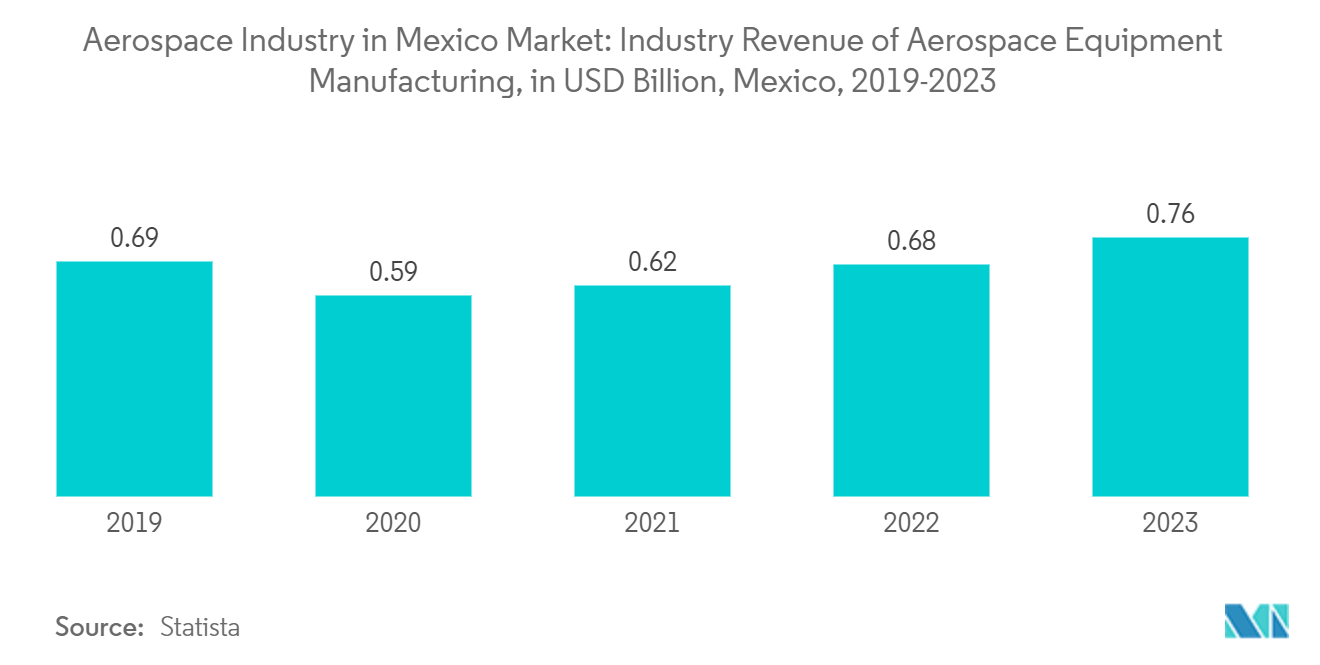
The Maintenance, Repair, and Overhaul Segment is Expected to Dominate the Market During the Forecast Period
Maintenance, repair, and overhaul is a key segment in Mexico. Significant growth in aircraft replacement parts manufacturing, as well as growth in local MRO capabilities, will lead to the market witnessing growth in the future. Furthermore, there has been a significant increase in the number of new aircraft acquisitions by various major airline companies in Mexico, bolstering the demand for advanced aircraft MRO within the country. For instance, in July 2023, Grupo Viva Aerobus SAB of Mexico announced that it had signed a preliminary order to acquire 90 Airbus A321 aircraft to cater to the growing expansion plans of the carrier in both the international and the domestic market.
Recognizing the vital role of a skilled workforce, Mexico focuses on tailored training programs to nurture talent specifically for the aerospace MRO sector. Collaborations between industry and academia ensure a steady supply of proficient technicians and engineers, bolstering the quality and dependability of MRO services. Consequently, Mexico is increasingly becoming the preferred choice for airlines and aerospace firms seeking top-notch maintenance solutions.
As Mexico's aerospace industry burgeons, underscored by the emergence of aerospace clusters and purpose-built MRO facilities, the MRO segment's dominance is further solidified. Substantial investments in cutting-edge infrastructure, from advanced hangars to diagnostic equipment, are boosting the capacity and efficiency of MRO operations. These advancements position Mexico favorably to handle a surge in MRO activities, catering to regional and international airline demands.
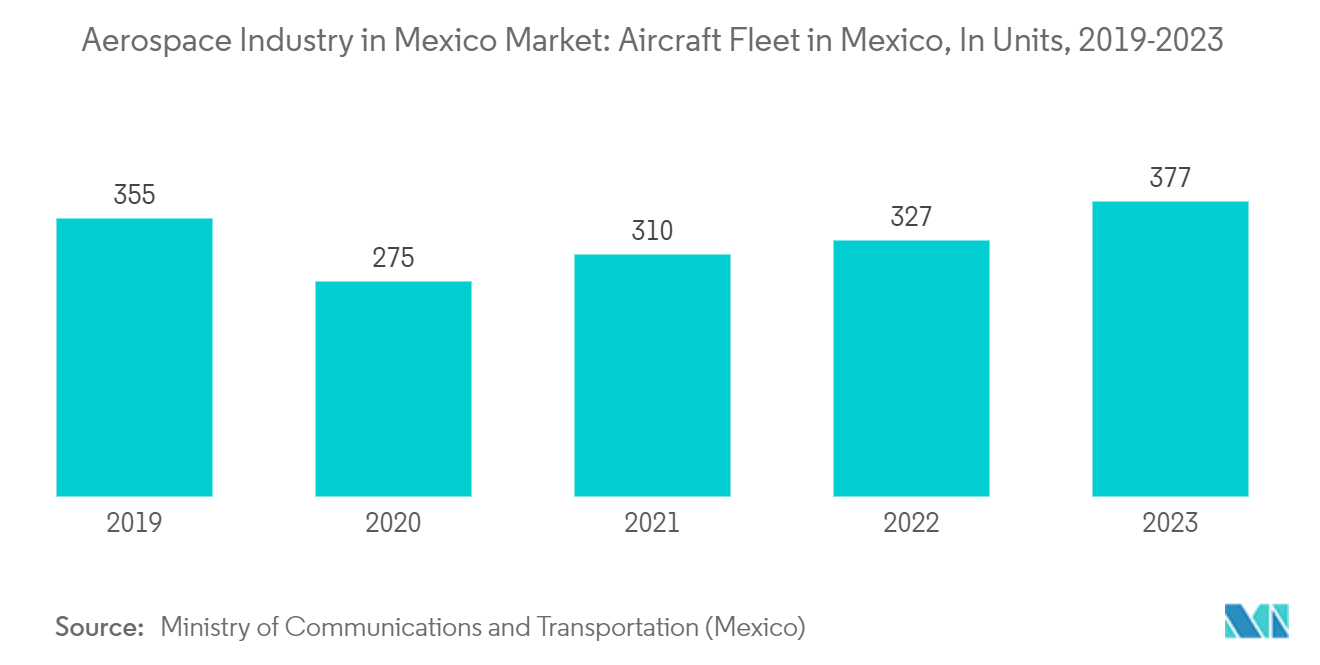
Aerospace In Mexico Industry Overview
The aerospace industry in Mexico is semi-consolidated, with few players dominating the market. The major players include Airbus SE, The Boeing Company, General Dynamics Corporation, Honeywell International Inc., and Bombardier Inc., amongst others.
Several players are ramping up domestic production of advanced aircraft equipment. With a burgeoning pool of skilled labor, major players are bolstering their investments in the nation's aviation sector. They focus on elevating their design and engineering prowess, setting the stage for heightened market competition in the coming years. Global aerospace giants like Bombardier, Airbus, and Boeing have established production plants and research centers in Mexico, underscoring the nation's pivotal role in the industry's global supply chain. These investments bring in capital, facilitate technology transfers, and introduce best practices and innovations, all crucial for the local industry's growth and capacity building.
Aerospace In Mexico Market Leaders
-
The Boeing Company
-
Honeywell International Inc.
-
Bombardier Inc.
-
Airbus SE
-
General Dynamics Corporation
*Disclaimer: Major Players sorted in no particular order
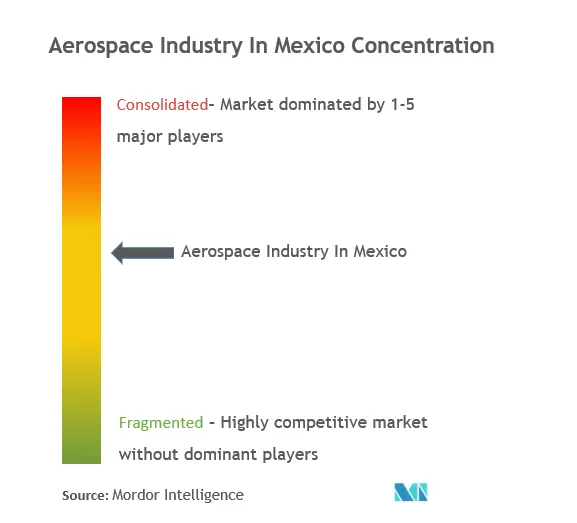
Aerospace In Mexico Market News
June 2024: Authorities from Mexico City, the State of Mexico, and Hidalgo, in collaboration with the Air Space Cluster, signed an agreement. This agreement is designed to bolster central Mexico's aeronautic sector, attract national and foreign investments, and elevate regional competitiveness. Mexico's aerospace industry boasts 450 companies, employs over 110,000 individuals, and has an annual market value of USD 4.6 billion.
March 2024: Mexicana de Aviación acquired 20 Embraer E2 aircraft, including 10 E190E2 and 10 E195-E2 jets, with deliveries set to commence in Q2 2025. With this move, Mexicana secured its position as Mexico's first E2 operator. Mexicana's choice of the E2 aircraft underscores its commitment to sustainability, leveraging its low operational costs and high fuel efficiency.
Aerospace in Mexico Market Report - Table of Contents
1. INTRODUCTION
- 1.1 Study Assumptions
- 1.2 Scope of the Study
2. RESEARCH METHODOLOGY
3. EXECUTIVE SUMMARY
4. MARKET DYNAMICS
- 4.1 Market Overview
- 4.2 Market Drivers
- 4.3 Market Restraints
-
4.4 Porter's Five Forces Analysis
- 4.4.1 Bargaining Power of Buyers/Consumers
- 4.4.2 Bargaining Power of Suppliers
- 4.4.3 Threat of New Entrants
- 4.4.4 Threat of Substitute Products
- 4.4.5 Intensity of Competitive Rivalry
5. MARKET SEGMENTATION
-
5.1 Industry
- 5.1.1 Manufacturing
- 5.1.2 Engineering and Design
- 5.1.3 Maintenance, Repair, and Overhaul
6. COMPETITIVE LANDSCAPE
- 6.1 Vendor Market Share
-
6.2 Company Profiles
- 6.2.1 Airbus SE
- 6.2.2 The Boeing Company
- 6.2.3 General Dynamics Corporation
- 6.2.4 Bombardier Inc.
- 6.2.5 Safran
- 6.2.6 Daher
- 6.2.7 Honeywell International Inc.
- 6.2.8 GKN plc
- 6.2.9 RTX Corporation
- 6.2.10 The General Electric Company
- 6.2.11 Eaton Corporation PLC
- 6.2.12 Mexicana MRO, S.A. de C.V.
- *List Not Exhaustive
7. MARKET OPPORTUNITIES AND FUTURE TRENDS
** Subject To AvailablityAerospace In Mexico Industry Segmentation
The study covers all aspects of the Mexican aerospace industry and provides insights into it. It also offers company profiles of major aerospace companies operating or offering their products and services in Mexico.
The aerospace industry in Mexico is segmented by industry into manufacturing, engineering and design, and maintenance, repair, and overhaul (MRO). For each segment, the market size is provided in terms of value (USD).
| Industry | Manufacturing |
| Engineering and Design | |
| Maintenance, Repair, and Overhaul |
Aerospace in Mexico Market Research FAQs
How big is the Aerospace Industry In Mexico Market?
The Aerospace Industry In Mexico Market size is expected to reach USD 2.58 billion in 2024 and grow at a CAGR of 2.76% to reach USD 2.96 billion by 2029.
What is the current Aerospace Industry In Mexico Market size?
In 2024, the Aerospace Industry In Mexico Market size is expected to reach USD 2.58 billion.
Who are the key players in Aerospace Industry In Mexico Market?
The Boeing Company, Honeywell International Inc., Bombardier Inc., Airbus SE and General Dynamics Corporation are the major companies operating in the Aerospace Industry In Mexico Market.
What years does this Aerospace Industry In Mexico Market cover, and what was the market size in 2023?
In 2023, the Aerospace Industry In Mexico Market size was estimated at USD 2.51 billion. The report covers the Aerospace Industry In Mexico Market historical market size for years: 2019, 2020, 2021, 2022 and 2023. The report also forecasts the Aerospace Industry In Mexico Market size for years: 2024, 2025, 2026, 2027, 2028 and 2029.
What are the potential challenges for foreign companies entering the Mexico Aerospace Market?
The potential challenges for foreign companies entering the Mexico Aerospace Market are a) Competition from established players b) Potential language and cultural barriers c) Navigating bureaucratic processes
What are the potential challenges for foreign companies entering the Mexico Aerospace Market?
The potential challenges for foreign companies entering the Mexico Aerospace Market are a) Competition from established players b) Potential language and cultural barriers c) Navigating bureaucratic processes
Mexico Aerospace Industry Report
The aerospace industry in Mexico is experiencing robust growth, driven by a favorable regulatory environment, increasing foreign direct investment, and a thriving manufacturing sector. The market size is expanding significantly, with key segments including manufacturing, engineering and design, and maintenance, repair, and overhaul (MRO) services. The industry outlook is positive, supported by Mexico's strategic location, low manufacturing costs, and a skilled workforce.
Regional hubs such as Baja California, Monterrey, and Nuevo León are pivotal in fostering innovation and expansion within the sector. The demand for MRO services is particularly strong, fueled by the need to modernize airline fleets and maintain military aircraft. Industry growth is also bolstered by trade agreements and collaborations with global aerospace giants, enhancing Mexico's competitive edge in the global market.
Aerospace companies in Mexico are focusing on scaling up their manufacturing capacities to meet growing export demands and support the nation's economic growth. The market forecast indicates sustained growth, driven by industry trends and market predictions. Industry statistics reveal a thriving sector with increasing market value and market segmentation.
The industry analysis shows a comprehensive overview of the market, highlighting the importance of industry information and industry research. The industry reports provide detailed insights into market data, market growth, and market outlook. The industry size and industry sales are expected to continue their upward trajectory, supported by industry research and market review.
In conclusion, the Mexican aerospace industry is well-positioned for continued growth, with strong industry reports and market leaders driving innovation and expansion. The industry trends and market overview suggest a bright future, with significant opportunities for research companies and industry stakeholders. The report pdf and report example provide further insights into the sector's performance and future prospects.



